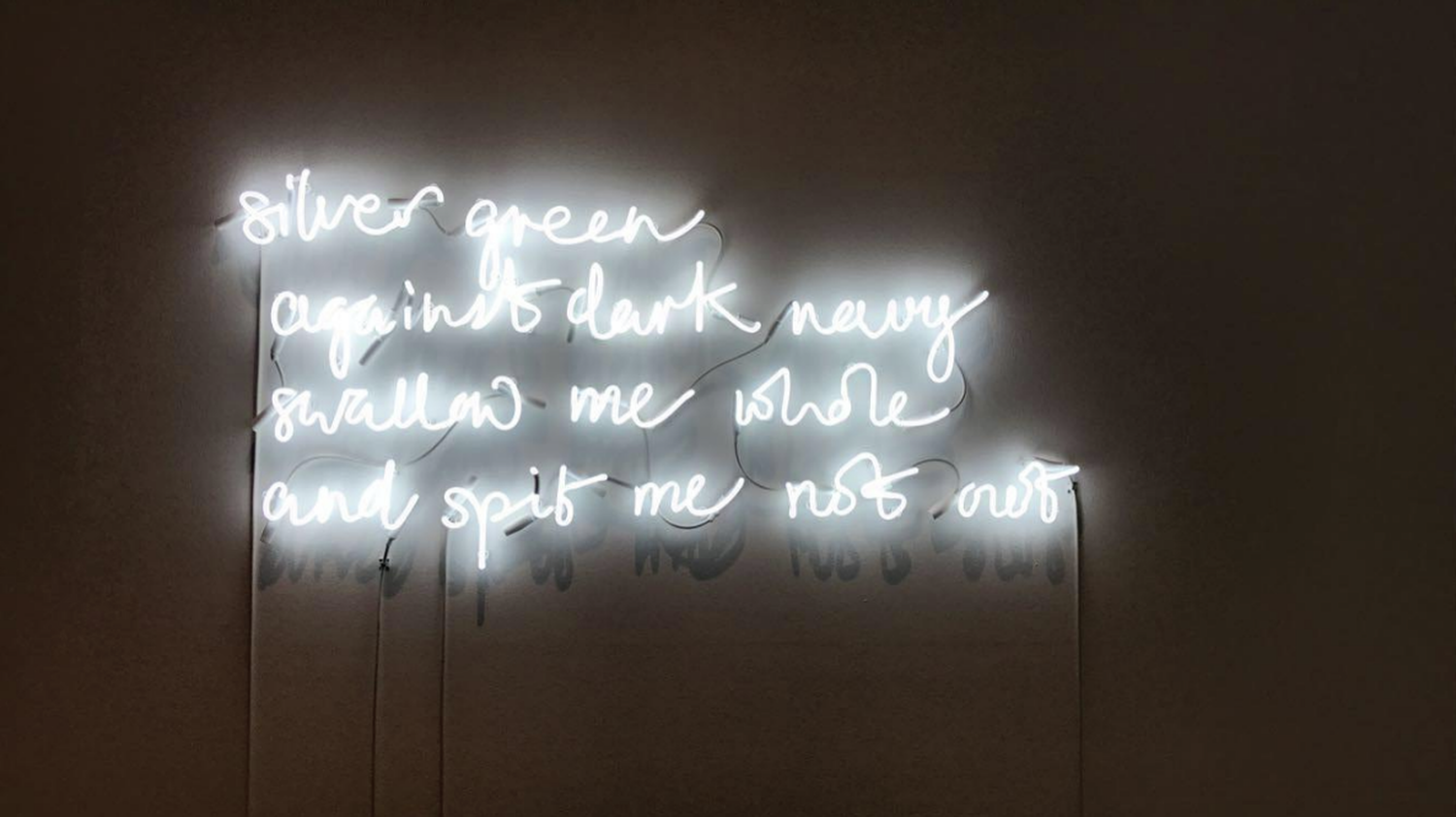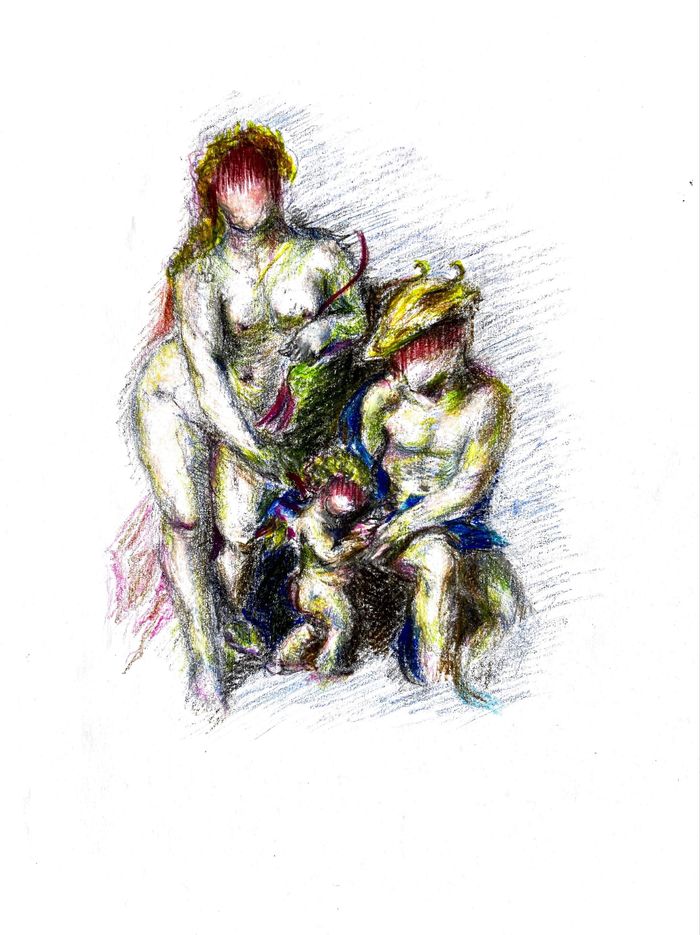I walk into the Kettle’s Yard exhibition space, and suddenly, from the gentle morning haze of Cambridge I find myself in a dark, looming space. Overlapping dark blue walls contain white text telling me about the artist and her artwork: it is already evident as to how light shapes the curation of the exhibit. Sutapa Biswas is a British Indian artist who made major contributions to the Black Arts Movement in Britain in the 80s, and continues to challenge Eurocentrism in the art world with Lumen, Biswas’ first big solo show in 14 years.
As I walk through the gallery on my left, I am confronted immediately by Biswas’ Housewives with Steak-Knives: a formidable painting depicting Biswas’ interpretation of Kali, the Hindu goddess who is considered the destroyer of evil, incorporating other symbols like a flag painted with Artemisia Gentileschi’s Judith Beheading Holofernes. Biswas centres the non-Eurocentric matriarch while drawing on the influence of feminists everywhere. The painting is hung at an angle so that the top leans forward towards you, the figure of Kali staring down. This angle marks a shadow on the white wall behind it: the interplay of light and shadows is intentional, and you can almost feel Kali’s (the housewife’s) glee in casting a shadow beyond the confines of her art canvas, shading white walls wherever she goes.
"Biswas centres the non-Eurocentric matriarch while drawing on the influence of feminists everywhere"
While the negative white space of the painting, juxtaposed with the housewife adorned in striking red, is meant to show her clash with white institutions, the creased paper that makes up this white background seems to hint to the decay of white imperial institutions, the fragility of the same in comparison to strong women of colour. The painting was rolled up regularly when it was first exhibited, and Biswas loves “the concept and the beauty of the resulting creases and shadows […] created on the surface of my painting because it challenged ideas of fixity and the longevity of art.” I look at it for a while longer and cannot stop thinking about how the creases don’t show on Kali, the years only make her stronger.
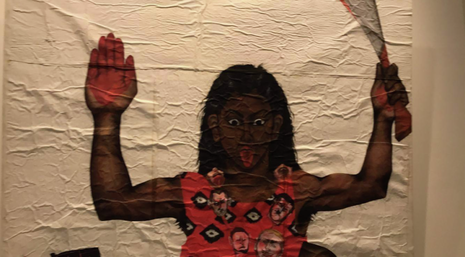
Biswas experiments with the materiality and spatial potential of her artworks: Housewives with Steak-Knives and To Touch Stone are both drawn on multiple sheets of paper framed together, rather than one large canvas. The themes of migration and separation, return and belonging that flow through her work are seen physically in the careful jagged edges between papers that seem to touch and retreat with unheeding precision. The fine lines of To Touch Stroke evoke an intensely tactile experience simply from viewing the different materials, techniques, and shadows: the dark and selective shading of the woman who resembles a statue at a temple draws attention to her lower body, away from her nipples. Biswas both desexualises the figure and manages to reclaim space for female body expression. The words and phrases that wrap around the figure add a simultaneously aural and visual element as if the woman is more than lines or color or words, and simply cannot be defined. At once, you can see how the drawing is deeply personal but also generalised, fragmented and still a monolithic presence in the gallery.
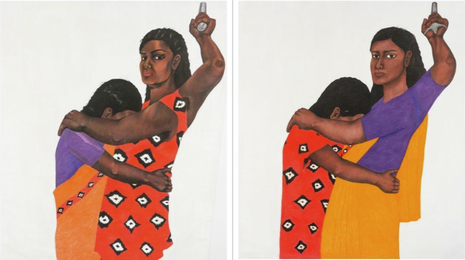
I speak to Amy Tobin, the curator of the exhibition, who points out to me the carefully planned, incredible circularity of the gallery that I have just floated through as if being led by my mum down a familiar street. Amy is right, in between the fragmented, giant presence of the two women figures is an intimate painting: a series of two moments with two women embracing each other. In each frame, one woman buries her head in the breasts of the other, while the latter takes charge of defending the bowed companion. The colourful sari and kurta they wear both attract and make them stand out against the plain white background. You can feel the intense comfort of the embrace while you are watched by the equally intense, sad, defiant glare of the protecting woman, fighting away unwanted stares with her own. It is a visual overflow of emotion and colour composition that makes you want to both look away and come back to take a second look.
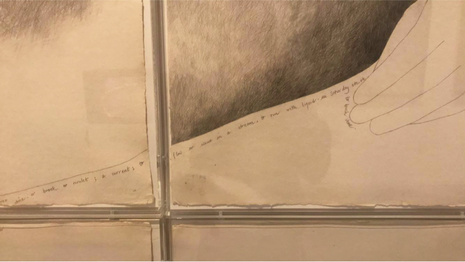
The female gaze, the interplay of light and shadow, and the strange sense of simultaneously destroying and reclaiming spaces haunts you throughout the gallery. Soft lights illuminate the artworks, a jarring distinction from the second gallery on the ground floor that is dedicated to displaying Biswas’ commissioned film Lumen at half-hour intervals. The film is “a semi-fictional narrative of migration, co-commissioned by Kettle’s Yard, Film and Video Umbrella, Bristol Museum and Art Gallery, and BALTIC Centre for Contemporary Art, supported by Art Fund through the Moving Image for Museums programme.” This gallery, on your right when you enter, is entirely made up of dark walls. In fact, the deep blue is so complete that when you sit down in front of the film projection it is impossible to look at anything but it, even when, in the deepest, most moving moments in the film you feel the urge to look away.
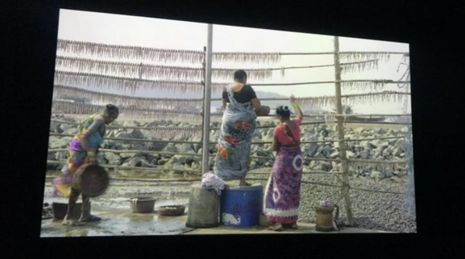
Only reinforced by this layout, the film succeeds in making its audience confront assumptions and privileges in addressing issues of colonialism, race, slavery, and migration. The actor, Natasha Patel, speaks while the film plays, sometimes delivering powerful monologues and other times voicing the film as different clips play on. The monologues are interspersed with clippings of the British East India Company in India alongside videos of modern-day India. Biswas thus unites history and memories with present day life, exposing the palimpsest of modernity as a fragment of dark histories that underlie it. The poetry spoken by the actress switches from echoing a retelling of Biswas’ mother’s experience, anticipation, and anxiety on leaving India for the UK, descriptions of India and its colonial past, and soundtracks of birds, market noises, beats, and haunting music. The black-and-white, sepia drenched intervals between caustic monologues help strip away every sense of nostalgia that is still connected to the commonwealth.
"Only reinforced by this layout, the film succeeds in making its audience confront assumptions and privileges in addressing issues of colonialism, race, slavery, and migration"
At one point Patel, removing a long strip of cloth from her mouth in an act of resistance that turns female subjugation and silencing into controlled production of the uncanny, is backdropped by her voice speaking ‘swallow me whole’. An electric sign buzzing in the first gallery displays the words: ‘silver green / against dark navy / swallow me whole / and spit me not out’. The defiant resistance of the words encapsulates the ways in which the exhibition commands introspection and questions institutions of power to make space for minority women. As I walk out of the dark film gallery the artworks lined against the white walls of the first gallery glow fiercely, exuberantly in comparison. I take more time to digest what I have just watched, and, walking past Biswas’ art for the second time I see the indelible quality of Lumen the exhibition produces. In a recorded interview on display alongside some archives on the first floor, Biswas says: “Lumen is a unit of light and it is about hope, and it’s about hope at a very dark time.”
Varsity were kindly invited by Kettle's Yard to a preview of the exhibition on Friday the 15th of October. Sutapa Biswas: Lumen is open from 16 October 2021 - 30 January 2022.

